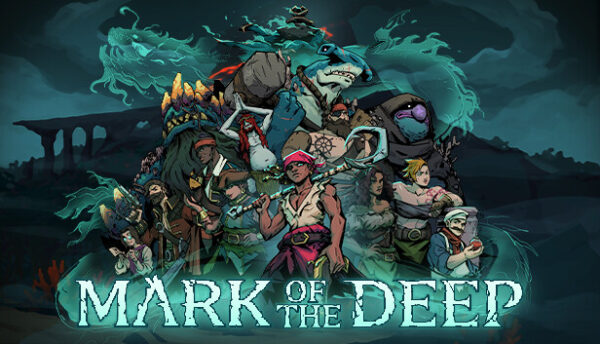Guest review by FKAGUNDAM
Off the bat, Mark of the Deep’s art style resembles that of 2020’s Hades, and with an isometric view, the comparison between both is shared in a similar playstyle. Though not a roguelike in execution, Mark of the Deep puts the pressure on you as if you were pillaging for coffers for treasure, absorb as much information from your environment as possible, explore every crevice in every level, and piece together whatever information you can from clues and writing in your surroundings. As you play the role of a marooned pirate, Mark of the Deep provides an entry to the adventure genre that packs a cannon blast unlike any prior entry with a mix of intrigue and discovery.

Mechanics:
As previously noted, Mark of the Deep plays and (maybe unintentionally) looks like the roguelike masterpiece Hades, both in terms of art and gameplay. The isometric view angle allows the player to control the character, Rookie, around the map/zone as they maneuver around enemies, breakables and in some parts, hidden areas. Rookie’s weapon is a hook on a pole and is wielded as a blade with a basic 3-swipe attack pattern. Though the combat seems simple, layers of complexity grow apparent when the player attains skills and upgrades for the hook, which not only impact combat, but also interactions with the environment.
As the player discovers abilities for the weapon, the environment opens new areas via use of the newfound weapon ability. This format of soft locking zones until a requirement is met forces the need to emphasize discovery and backtrack onto previously ventured zones, which can undoubtedly be a sort of detractor from other hack and slash games. Granted, unlike roguelikes – or any other game that penalizes the player dying – Mark of the Deep doesn’t discourage the player by removing upgrades, currency or discoverable items from your inventory.
Aside from standard mechanics from adventure/hack and slash games like save points, health upgrades, merchant inventory, or traveling between save points, the most important mechanic in Mark of the Deep would be its short cut paths. Similar to soulslike games, these shortcuts serve as a sort of benchmark in the game, as well as respite from whatever the player needs to do in order to progress further.

Graphics:
In short, Mark of the Deep is not a showcase of flash or serves to push the boundaries of your computer’s graphical output. Regardless, the game offers options to accommodate certain graphical aspects found in the game’s environment, such as foliage. Even with low settings, the background looks, sounds, and feels animated throughout the game.
The placing of hand drawn characters and the 3D environment helps contrast the range that the art department managed to accomplish while designing the game. The characters look like a proper pirate crew, voice and all. The environment evokes a feeling of ancient history being uncovered, and the enemies look like they belong in a forgotten land at the bottom of the ocean.
Gameplay:
Hack and slash games often map hostile enemies in various formats: one zone with one type of enemy, another with various types of enemies at once, or a zone that mixes in traps and enemies who prioritize use of said trap. In Mark of the Deep, the enemies are plenty and have a vast arsenal of attack patterns, from the entry level enemies all the way to the bigger brutes. It’s not just the number of enemies found in the area that prevent the player from a moment’s respite, but the attack patterns of certain enemies make it sure that not even having a moment to heal is possible.

The game encourages fast in-and-out game style instead of ranged projectile one, making each boss encounter especially tedious. Unlike some side scrollers, this game has pitfalls both in levels and in some boss arenas. I found the element of losing health via falling off the map rather pointless due to the combat’s difficulty being centered around a fast, close to mid-range, aggressive playstyle. Nevertheless, some of the upgrades for the hook create a whole new playstyle for the player, but until the player discover the upgrades, there’s little to no way around a semi-forced playstyle.
Another key mechanic that is crucial to the game is the incorporation of trinkets, which work in a similar way to charms in Hollow Knight. These trinkets are found while exploring, and unlike Hollow Knight, the ability to potentially equip more than two or three trinkets can be attained as the player progresses through the game.
Conclusion:
As a big fan of 2020’s masterpiece Hades, I’ve thoroughly enjoyed Mark of the Deep as its own version of a roguelike/metroidvania/hack-and-slash/action game. The story is engaging enough to not forget, while the backstory is interesting enough to not forget whenever the game is being played. The in-game quests encourage the player to check through every opening there is in each level, the combat is simple enough for anyone to adapt to, and the little need to farm for currency make it a fast, memorable, and remarkable experience in my book.

On a sidenote, this is the first game from a Brazilian video game developer team that I’ve played, and almost immediately, the passion, dedication, and intricacies become well apparent. When it comes to gameplay, Mark of the Deep is a dynamite explosion of fun and delight that could be addiction. When it comes to narrative and art, there’s certainly something for players who enjoy lore and appreciate vivid characters and a vivid world.
Disclaimer: A review key was provided

